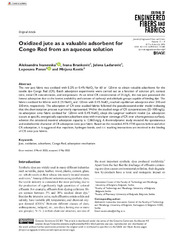Приказ основних података о документу
Oxidized jute as a valuable adsorbent for Congo Red from an aqueous solution
| dc.creator | Ivanovska, Aleksandra | |
| dc.creator | Branković, Ivana | |
| dc.creator | Lađarević, Jelena | |
| dc.creator | Pavun, Leposava | |
| dc.creator | Kostić, Mirjana | |
| dc.date.accessioned | 2023-01-13T10:21:13Z | |
| dc.date.available | 2023-01-13T10:21:13Z | |
| dc.date.issued | 2022 | |
| dc.identifier.issn | 1558-9250 | |
| dc.identifier.uri | http://TechnoRep.tmf.bg.ac.rs/handle/123456789/5347 | |
| dc.description.abstract | The raw jute fabric was oxidized with 0.2% or 0.4% NaIO4 for 60 or 120 min to obtain valuable adsorbents for the textile dye Congo Red (CR). Batch adsorption experiments were carried out as a function of solution pH, contact time, initial CR concentration, and temperature. At an initial CR concentration of 25 mg/L, the raw jute possessed the lowest adsorption due to the lowest availability and content of carboxyl and aldehyde groups capable of binding dye. The fabrics oxidized for 60 min with 0.2% NaIO4 and 120 min with 0.4% NaIO4 reached equilibrium adsorption after 240 and 330 min, respectively. The adsorption of CR onto studied fabrics followed the pseudo-second-order model indicating that the chemisorption process is primarily represented. Within the studied range of CR concentrations (25–100 mg/L), its adsorption onto fabric oxidized for 120 min with 0.4% NaIO4 obeys the Langmuir isotherm model (i.e. adsorption occurs at specific, energetically equivalent adsorbent sites with monolayer coverage of CR over a homogeneous surface), wherein the calculated maximal adsorption capacity is 12.863 mg/g. A thermodynamic study revealed the spontaneous and endothermic character of CR adsorption onto jute fabric. Based on the recorded ATR-FTIR spectra before and after CR adsorption, it is suggested that repulsion, hydrogen bonds, and π-π stacking interactions are involved in the binding of CR onto jute fabrics. | sr |
| dc.language.iso | en | sr |
| dc.publisher | SAGE Publications Ltd. | sr |
| dc.relation | info:eu-repo/grantAgreement/MESTD/inst-2020/200287/RS// | sr |
| dc.relation | info:eu-repo/grantAgreement/MESTD/inst-2020/200135/RS// | sr |
| dc.relation | info:eu-repo/grantAgreement/ScienceFundRS/Ideje/7726976/RS// | sr |
| dc.rights | openAccess | sr |
| dc.rights.uri | https://creativecommons.org/licenses/by/4.0/ | |
| dc.source | Journal of Engineered Fibers and Fabrics | sr |
| dc.subject | adsorbent | sr |
| dc.subject | adsorption mechanism | sr |
| dc.subject | Congo Red | sr |
| dc.subject | Jute | sr |
| dc.subject | oxidation | sr |
| dc.title | Oxidized jute as a valuable adsorbent for Congo Red from an aqueous solution | sr |
| dc.type | article | sr |
| dc.rights.license | BY | sr |
| dc.citation.rank | M22~ | |
| dc.citation.volume | 17 | |
| dc.identifier.doi | 10.1177/15589250221101380 | |
| dc.identifier.fulltext | http://TechnoRep.tmf.bg.ac.rs/bitstream/id/13948/Oxidized_jute_pub_2022.pdf | |
| dc.identifier.scopus | 2-s2.0-85130749698 | |
| dc.identifier.wos | 00080019810000 | |
| dc.type.version | publishedVersion | sr |

